Good afternoon, lovelies! As you may have noticed, it's been a bit quiet around here lately. Between traveling, writing on a deadline, and unexpected (though beloved) visitors, my free time has been greatly reduced. I'm hoping to catch back up on the Autumn of 1000 Shirtdresses over the next week, but I also am considering bumping the challenge due date back. Considering we're going to into the holiday season, I can't be the only one warring with a busy schedule!
However, today and tomorrow, I'm focusing on bust adjustments. This is one of those areas where I'm pretty well versed in some techniques, but have zero experience with others. Since I usually just sew for myself, I have done innumerable full bust adjustments, but never even sniffed around a small bust adjustment. To that end, tomorrow, I'm going to round up links to well-vetted and helpful bust adjustments, including techniques I don't have personal familiarity with. Today, however, I thought I'd share my own FBA for McCall's 6696.
This adjustment is the most basic of FBAs, for a two-dart bodice. If you are using any pattern with a bust and waist dart, this exact alteration will also work for you! There are more complicated FBA techniques, as almost no problem in sewing has just one answer, but this is the tried-and-true method I usually begin with.
First off, who needs an FBA? It's going to depend on the pattern you're using, but most Big 4 patterns are drafted using a B-cup bodice and it's rare that Indies are drafted larger than C-cups. If your bra size falls outside this range, then an FBA is for you! Even if your measurements are exactly identical to those on the pattern envelope, chances are weird fitting issues will crop up with a large cup size. It's astounding the number of these issues a good FBA can fix, from floppy shoulders to gaping button bands. Today, we're going to walk through the most basic of FBAs, for a two-dart bodice, but virtually every pattern design can be adapted for large cup sizes.
Before we start the adjustments, however, let's pick a pattern size. McCall's 6696 is a classic two-dart shirtdress pattern with multiple cup sizes. All of the Big 4 pattern companies have introduced pattern lines with multiple cup sizes, which is great because it does a lot of the FBA work for us! This particular pattern goes up to a D cup, which means I still need some room to accommodate my ample 36E bosom.
This pattern goes up to a size 24, or bust measurement of 46 inches (47 for the D-cup piece). It's tempting to look at a pattern size chart and pick based on your usual bust measurement, but that way danger lies. If I made a size 24, it would be a gaping mess everywhere but my girls! Instead, the best method is to choose a bodice based on your high bust measurement.

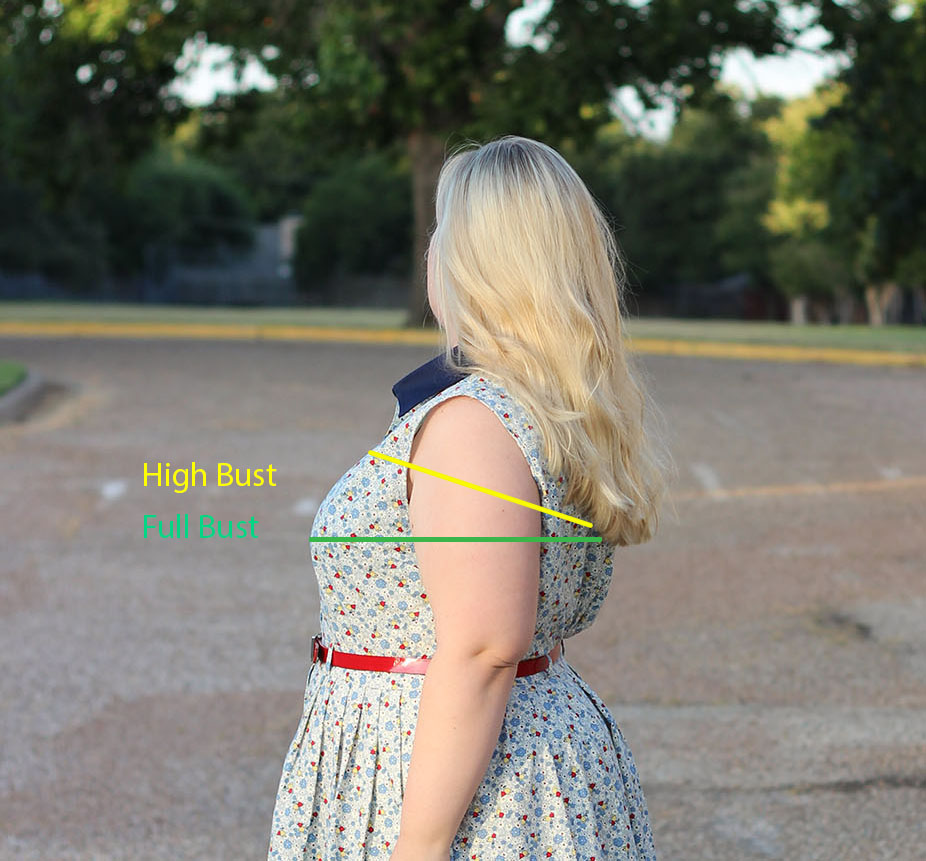
In a well-fitting bra, measure yourself all the way around the very top of your bust line, under your arms and over the beginning of your décolletage. That's your high bust! Now, measure around the fullest part of your bust line. Tada! That's--surprise, surprise--your full bust.
If you're a large cupped woman, these two numbers will be pretty different. My own measurements are a high bust of 41 inches and a full bust of 46 inches, which lines up with my 36E bra size. (Conventional wisdom states that every cup size is an extra half-inch measurement, though you may find this doesn't hold true for you, depending on fit preference.) Above, I've marked my own high bust and full bust, in a side profile picture. See how different those two parts of my bust are? If I pick a size with my high bust measurement, I'm between the size 18 and size 20 bodice, rather than our original size 24. Since my shoulders are wider than average and my waist is a solid size 20, that's the size I usually choose to perform an FBA on.
Note: You may have to grade between sizes at the waist and hip, depending on your proportions and measurements. It's not rare at all to need a size 20 bodice with an FBA, then a size 24 elsewhere. Women, no matter what fashion tells us, are not a standardized shape. That's why we sew, right? The important thing here is getting the right size upper bodice base for your shoulders and upper chest. You can easily grade out to other sizes, for your waist and hips.
Now, let's adjust!
Preparations:
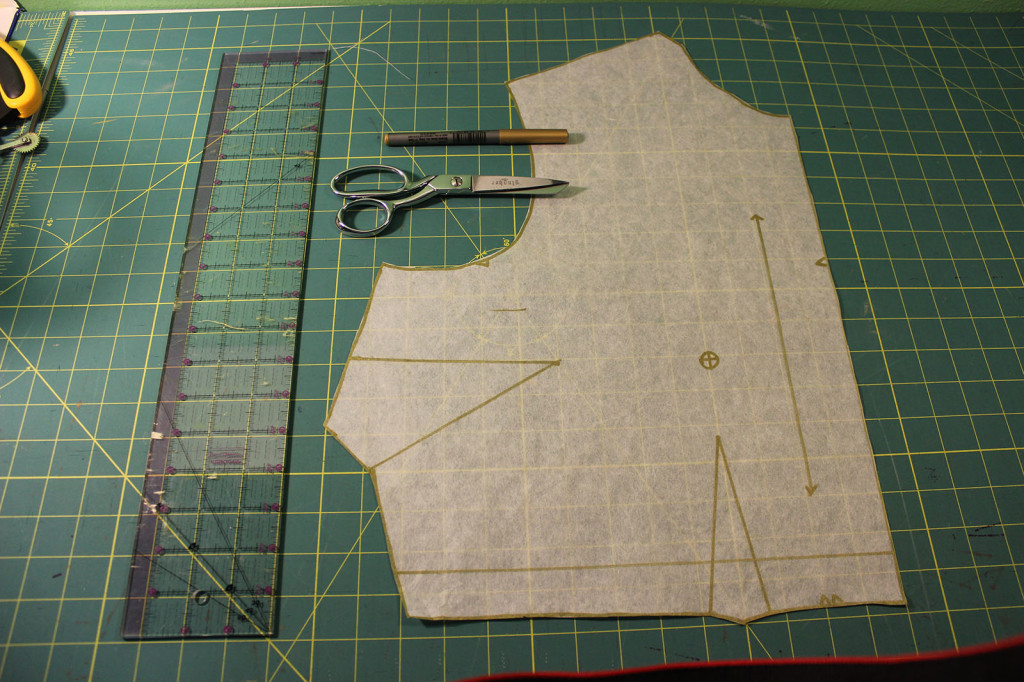
To get started we're going to need a few materials.
-
Your pattern! Instead of using the original tissue pattern, I highly recommend tracing your pattern onto a more durable type of paper. We're going to be slashing and spreading this baby, after all. Tissue paper is just too flimsy to handle that workmanship! Besides, if you end up wanting to change the fit, it's nice to not have irrevocably messed up the original bodice. Personally, I use Swedish Tracing Paper, which is not only easy to trace on, but sewable for quick fitting checks. Bee Paper is another excellent, very hearty choice.
- A clear ruler!
- Pattern weights! I use large metal washers, which are both weighty and have slim profiles that make cutting around them a breeze.
- A sharpie or pen!
- Scissors!
- Tape!
Step One:
The goal of an FBA is to add fullness to your pattern piece, without sacrificing the fit at your shoulders and waist. To do that, we're going to draw a few lines on our pattern, then cut them to specific points, so that the piece only gets larger where we want! Are you ready? Grab that sharpie, my dear. (Note: Because my own markings were faint, for teaching purposes, I will be showing you this process with bright computerized lines, to make it easier for us all!)

Step Two:

Now, draw Line #2 from your bust point out to your armscye, about 1/3 of the way down from the shoulder. (Shown above in bright blue.) The reason we only go 1/3 of the way down the armscye is to prevent over-distortion of our armhole, which would give us too much blousing on the side.
Step Three:
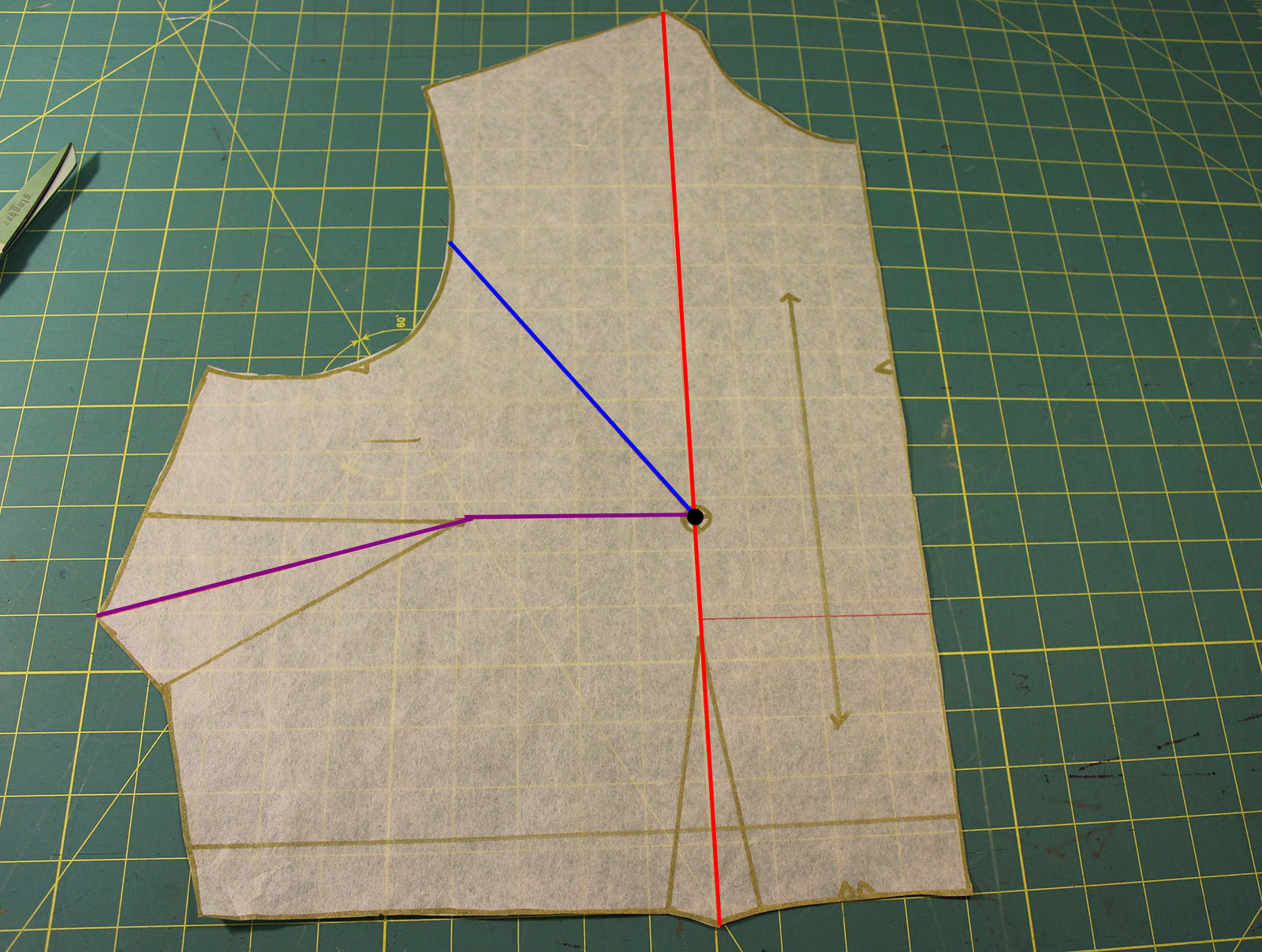
Next up, we're going to draw a line through our side bust dart to the bust apex. There are two main types of side bust darts you'll encounter: those positioned horizontally to an apex and those which angle up. For both types of dart, we draw Line #3 from the middle dart edge, through the dart tip, over to the bust point. If you're working with a horizontal dart, this will be a perfectly straight line. How easy! If you have an angled dart, as I do, there will be a hinge in your line like my purple one above.
Step Four:
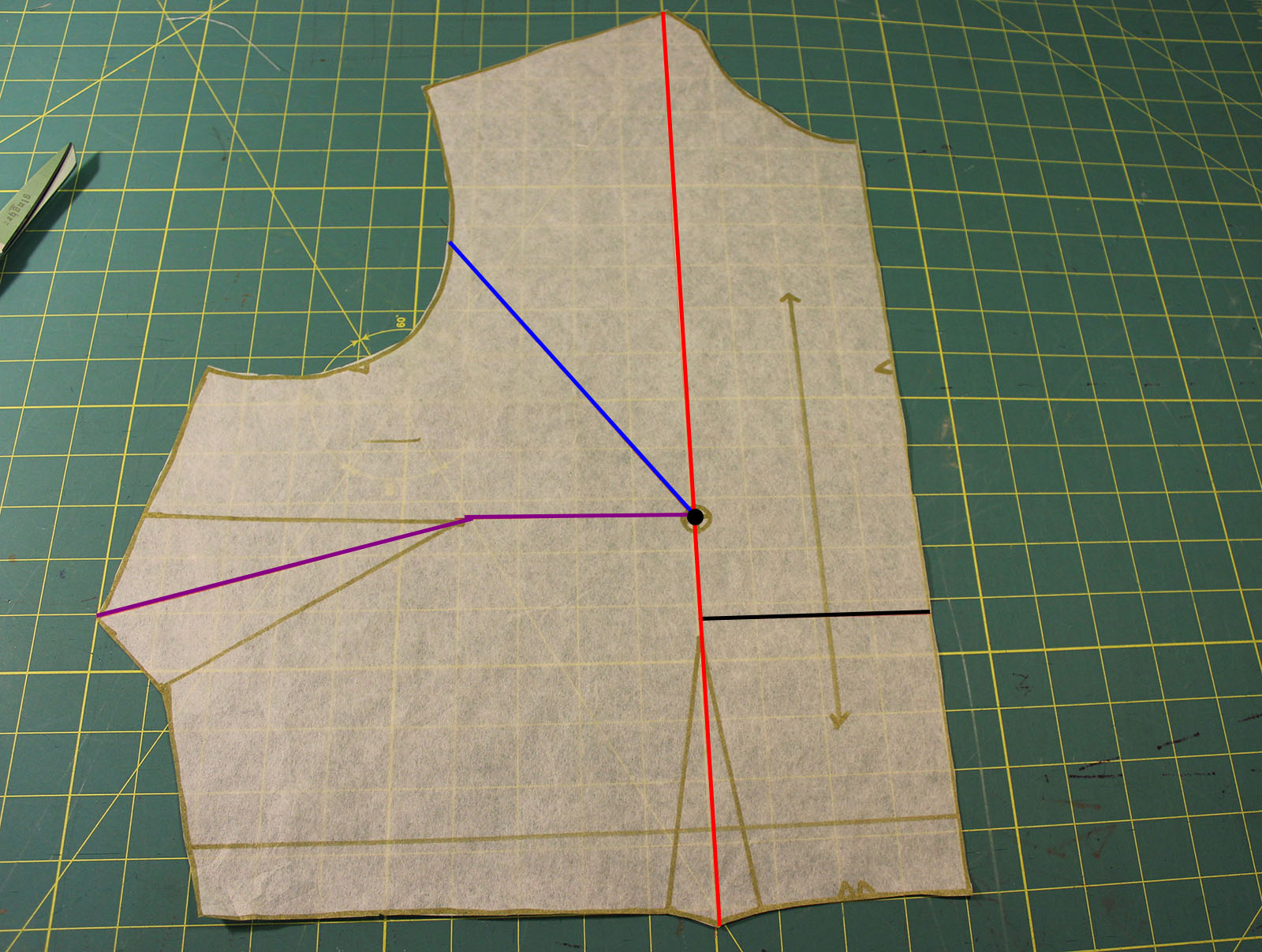
The final line we're going to draw is an easy one. From your center front, draw a straight horizontal line to Line #1, just above where your waist dart ends. I've done this in black above!
Woohoo! All your FBA lines are drawn! Not so hard, right? Now, onto the fun cutting parts...
Step Five:

For our first cut, we're going to go up through Line #1 to the bust point, then pivot right there and continue along Line # 2 to your armscye. At the end of Line #2, stop cutting just before the line ends, leaving a small bit of line left intact (about 1/8 inch). We don't want to cut our pattern piece in two, just make it mobile enough that we can spread it out a bit. Leaving this little bit left gives us a "hinge," to move the bodice around.
Step Six:
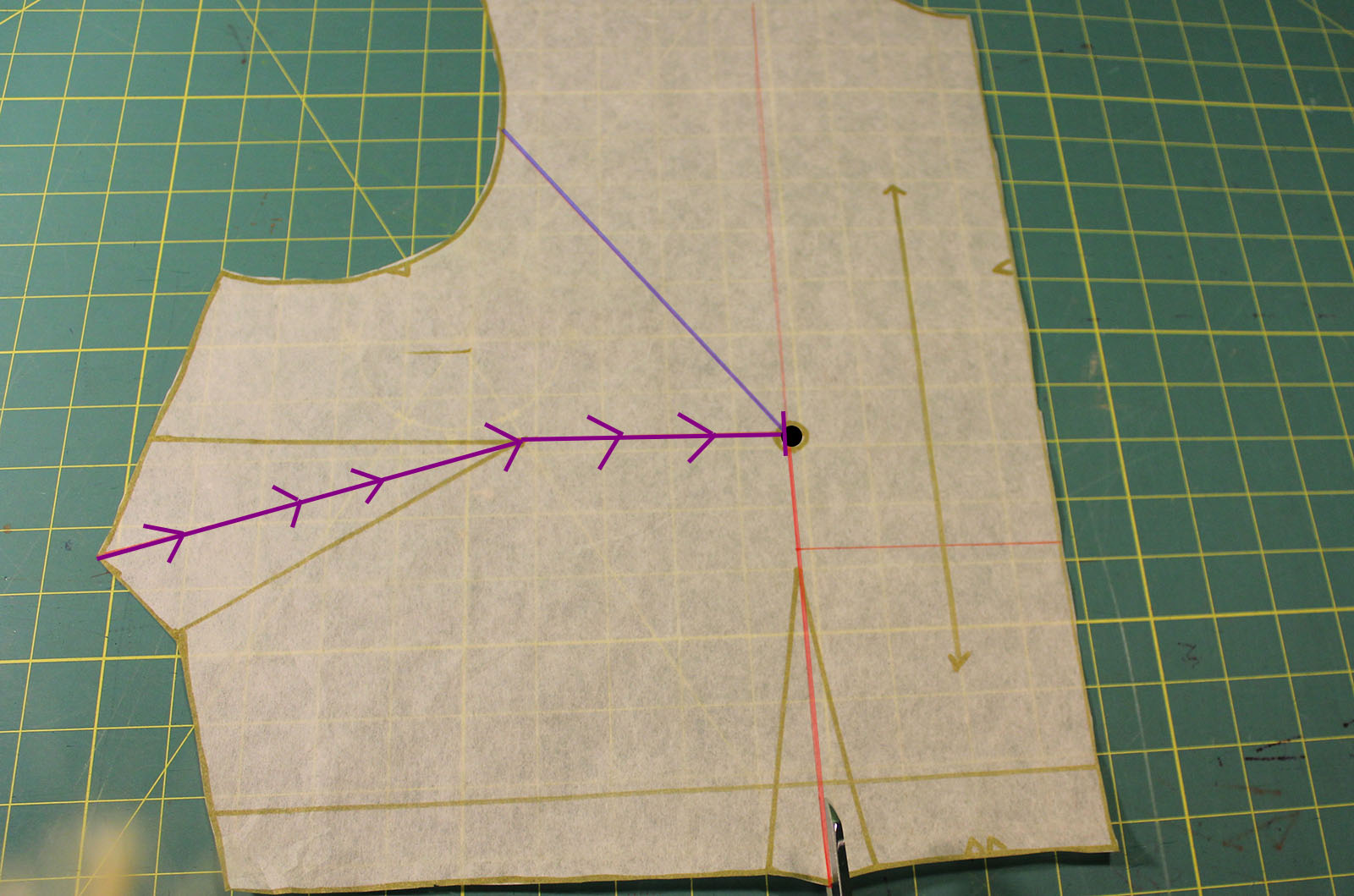
For our next cut, we're going to cut along Line #3, starting at the dart side and stopping again just before the bust apex, leaving another hinge. See how you can now spread your bodice pieces out quite a bit? The step below shows our new pattern piece, complete with hinges and cuts!
Brief Interlude of Math
Now that your pattern piece is all hinged, we can add in the fullness needed to compensate for our full bust measurement. How much extra room do you need, however? There are a few ways to determine how much extra fullness you need, but I go with the simplest version. How much difference is between your Full Bust and the stated Bust measurement on the pattern size? Since I'm using a Size 20, D-cup pattern piece, there is a two inch difference between my measurements and those of the pattern size. (Pattern's body measurement: 44 inches; My full bust: 46 inches) That means I need to add an extra two inches to the bodice pattern! Easy, right?
Since a bodice pattern piece is only half of a full bodice, however, this means I'm making a 1-inch FBA.
2 extra inches needed ÷ 2 bodice halves = 1 inch FBA
(Extra Room Needed ÷ 2 Bodice Halves = FBA width)
Note: For some multi-cup-size patterns, the stated body measurement for larger cup sizes may not be available. To combat that, subtract your desired ease from the pattern piece's final measurement, which is always found on the printed pattern. For me, on McCall's 6696, I wanted about two inches of ease in the front bodice.
Now, let's start spreading!
Step Seven:
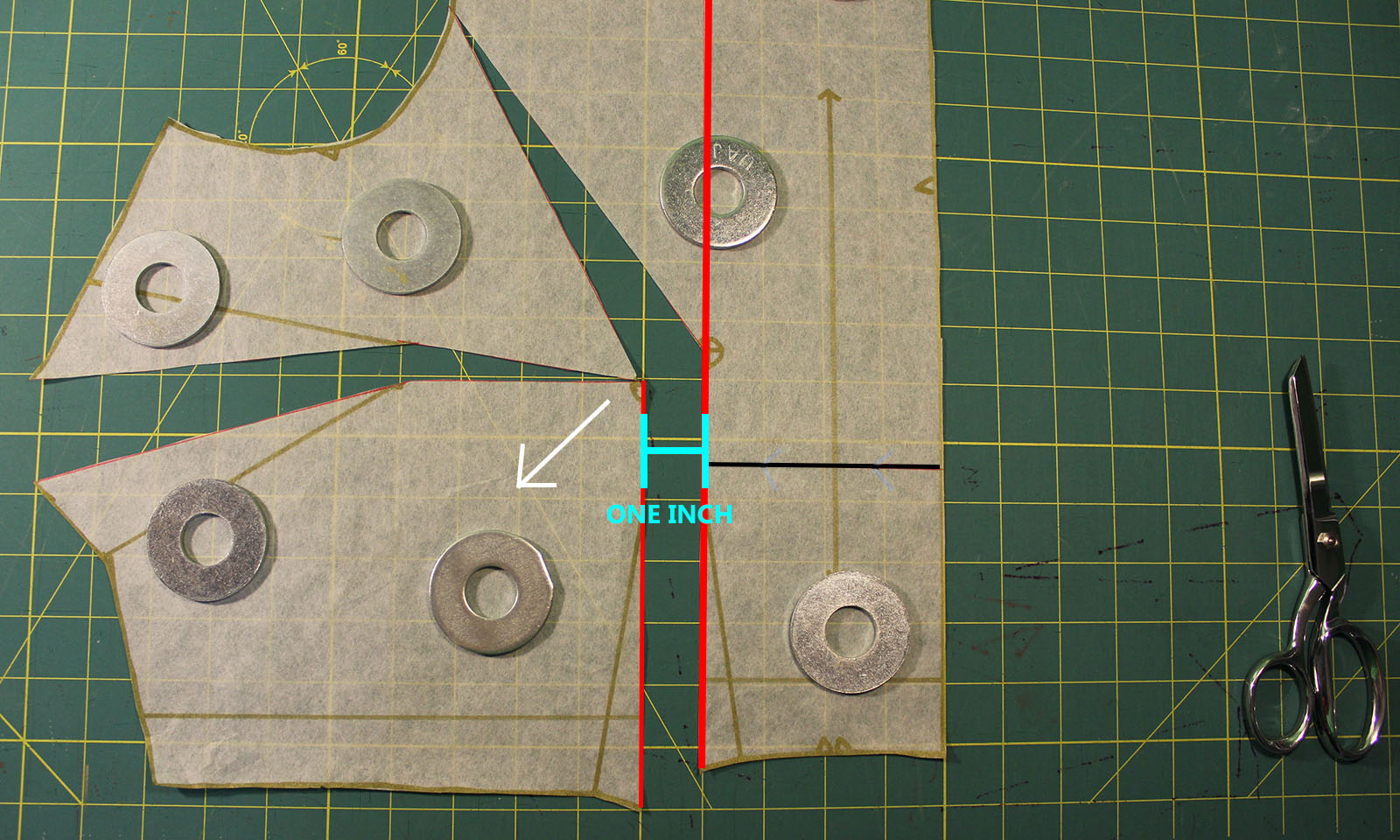
The extra fullness we're adding in gets directly added to Line #1, the bright red one that went up from our waist dart. To do this, secure the center front of your pattern piece, then spread your hinged lower bodice down and to the left. Being careful to keep the slash along Line #1 straight, spread your pattern piece out until there is one inch* separating the split Line #1.
See how your dart and armscye have also moved to accommodate your new Line #1? That's exactly what we want. Now, make sure every part is laying flat and your split Line #1 is still straight, with an inch separating it all the way down, then put pattern weights all over the place!
*Use the measurement you got from our Math Interlude. If you're doing a 2-inch FBA, spread it 2 inches, and so forth.
Step Eight:

Now that your pattern piece is slashed and spread, it's time to make our final cut. You know Line #4? Cut clean through it, from the Center Front all the way to the red line, as demonstrated in black above.
Step Eight:
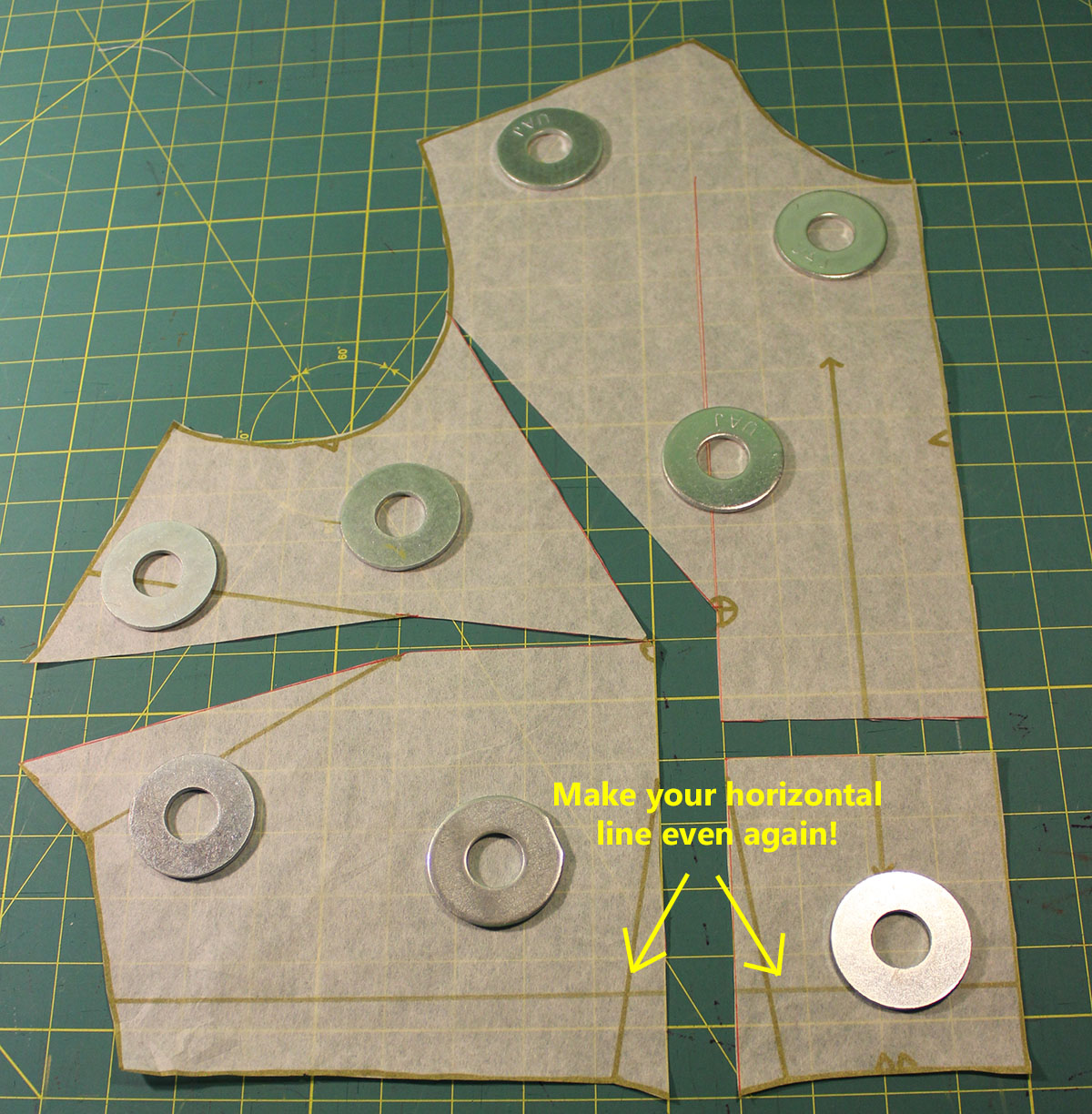
Move that little bodice piece down, until your horizontal lengthen/shorten line is once again even. Secure with a pattern weight!
Step Nine:

Very carefully put scrap paper underneath all the holes on your pattern, without shifting it around. (Hooray pattern weights!) Tape this scrap paper down. At each dart, leave extra paper past the pattern's end. We're going to redraw these darts next and will need the extra room!
Step Ten:
Are you excited about redrawing darts? We're so close to the end. First off, however, we need to mark your bust apex on the new pattern piece. To do this, hold the piece up to yourself and mark the fullest point of your bust on the pattern piece. I've marked my own in blue in the image below.

Now, there are some standard rules with darts that nobody tells you. You definitely don't want these puppies going all the way to your bust apex. That's how dreadful, pointy hideousness happens! The standard rule of thumb is to position the dart tips one inch away from your bust apex. For larger cup sizes, however, this rule doesn't always hold true. If you have a large bosom, your actual bust apex takes up more room, after all. Over time, you will find what works best for you, but for large busts, I like the dart tips to be two inches from the apex instead.
To mark these, measure two inches to the left of your bust apex, then mark that dot for your side bust dart. Then, measure two inches below your bust apex, and mark that dart for your waist dart. I've marked these dots in purple in the above image.
You have new dart ends! Woohoo!
Note: Some people prefer to mark their apex, before doing an FBA spread, but this depends on personal preference. Whatever order you find the most helpful will come to the same end! I find that my apex is rarely in line with the pattern's apex, but instead on a horizontal plane, just to the outside. (I'm told that this is a common Very Large Bosom issue.) For this reason, I mark it after slashing and spreading, so that I can better see how the dart placement is. If your apex does not line up with the original pattern's or your new slashed bodice, it's really easy to move your darts. I like to do this, after finishing the FBA and find this method particularly helpful.
Note: Some people prefer to mark their apex, before doing an FBA spread, but this depends on personal preference. Whatever order you find the most helpful will come to the same end! I find that my apex is rarely in line with the pattern's apex, but instead on a horizontal plane, just to the outside. (I'm told that this is a common Very Large Bosom issue.) For this reason, I mark it after slashing and spreading, so that I can better see how the dart placement is. If your apex does not line up with the original pattern's or your new slashed bodice, it's really easy to move your darts. I like to do this, after finishing the FBA and find this method particularly helpful.
Step Eleven:

It's now time to redraw your side bust dart! To do this, use your ruler and draw two straight lines from the original dart ends, to your new dart tip. I've done this in purple above. Completely ignore the original dart legs. You're blazing your own path and don't need to follow those! Just go straight to your personal dart tip.
Step Twelve:

Repeat the same process for your waist dart. Beginning at your original dart ends, draw two straight lines up to your new dart tip. Once again, completely ignore that you're not following the original dart legs. Those don't matter for your needs.
Step Thirteen:
We're so close to the end! We just need to get rid of all that extra paper.
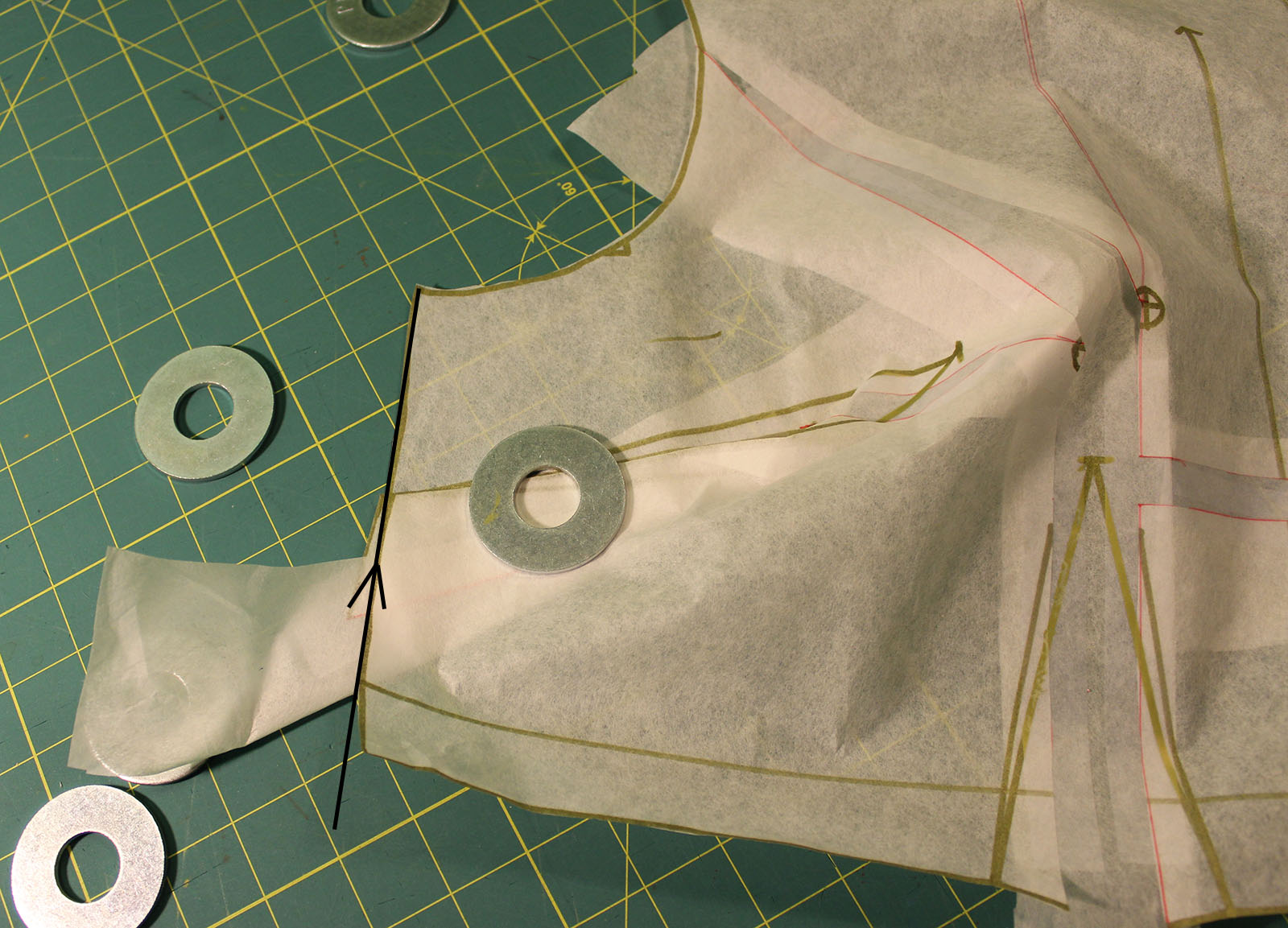
To do this, fold your new dart legs together, as I have done above on the side bust dart. Once you've folded them together, cut across the end of your pattern piece, noted in black in the above image. Voila! A complete dart is formed! Repeat this process for your second dart.
Step Fourteen:

Finally, trim that extra paper along your armscye!
Step Fifteen:
You're done! Do a happy dance!
Then, make a muslin of your new bodice and see how you like the fit.
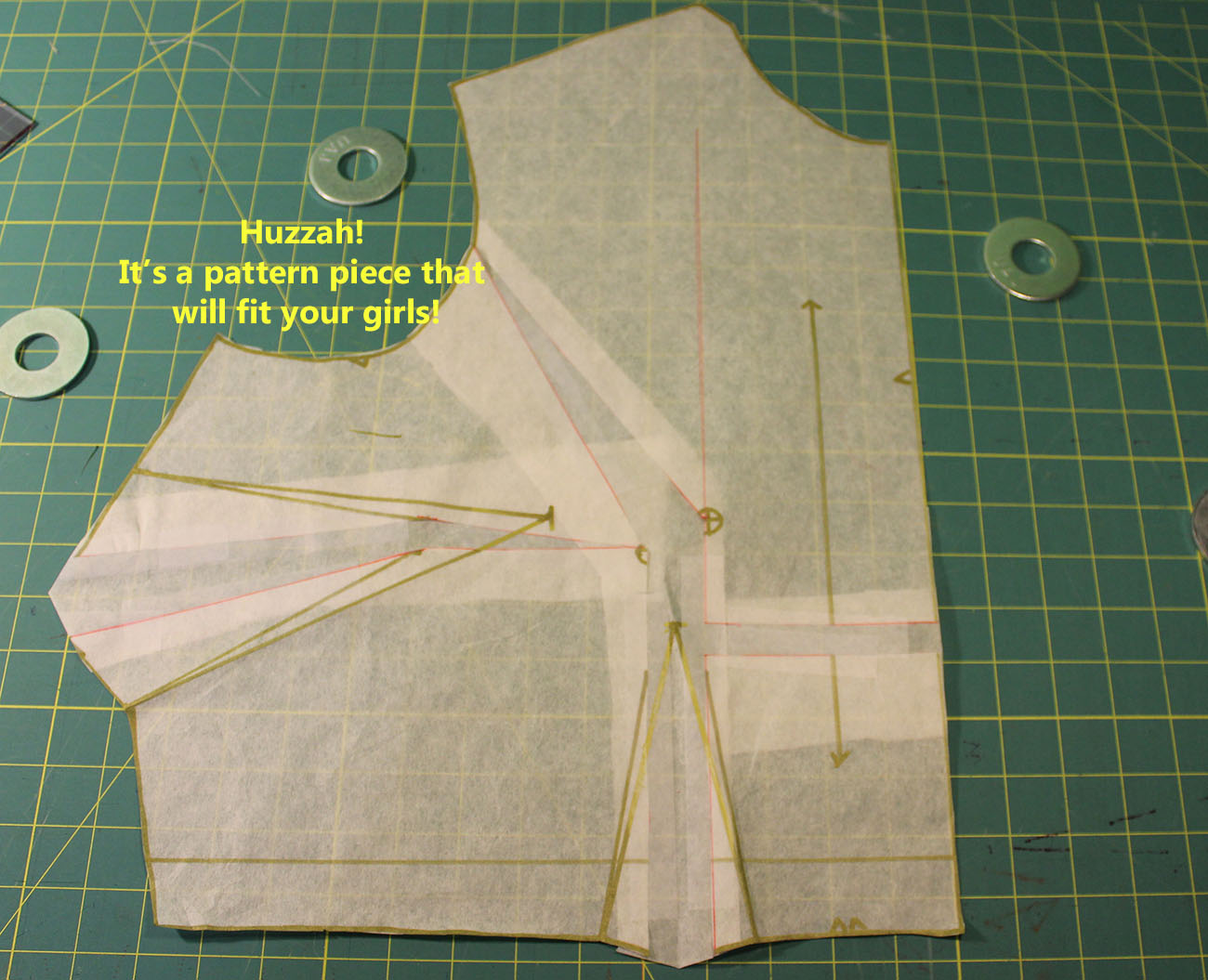

There are, of course, more advanced FBA techniques to cover, but this is a good basic process. You will be amazed by what a simple FBA can do to fix fitting woes! After completing this exact FBA, I ended up with the perfectly fitted bodice of my green shirtdress above. It's so worth the effort, don't you think?
Tomorrow, I'll round up a list of my favorite tutorials for other bust adjustments. This will include a small bust adjustment, dividing unwieldy darts, and moving bust points. There are, also, the aforementioned more complex versions of an FBA that I'll include, for those who are curious about other methods.
Note: All Amazon links in this post are now affiliate links, which means I could get a tiny portion of anything referred from this site.
Note: All Amazon links in this post are now affiliate links, which means I could get a tiny portion of anything referred from this site.


No comments
Post a Comment